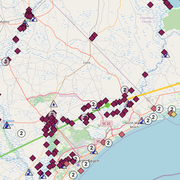Field Trip with PAWSC staff to a Delaware River NGWOS station in Philadelphia, Pennsylvania
Field Trip with PAWSC staff to a Delaware River NGWOS station in Philadelphia, PennsylvaniaThe Delaware River is rich in history, ecologically diverse, and critical to the regional economy. Water managers in this basin have a long history of applying innovative, regional solutions to ensure the long-term sustainability of this treasured resource which provides drinking water to over 15 million people in the region.














